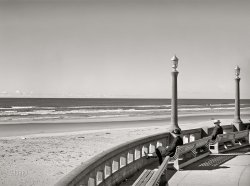
MAY CONTAIN NUTS

Search Shorpy
SHORPY ART

Framed or unframed, desk size to sofa size, printed by us in Arizona and Alabama since 2007. Explore now.
Join and Share
Ad-Free Shorpy
Shorpy is funded by you. Patreon contributors get an ad-free experience.
Learn more.

Recent comments
- Details, Details
- What's that building to the left of the tower?
- Coal Barges
- Bromo-Seltzer
- Inner harbor
- The Basin
- What a headache!
- Giant stepladder?
- Baldwin 62303
- Baldwin VO-1000
- Cold
- No expense spared
- Tough Guys
- Lost in Toyland
- And without gloves
- If I were a blindfolded time traveler
- Smoke Consumer Also Cooks
- Oh that stove!
- Possibly still there?
- What?!?
- $100 Reward
- Freeze Frame
- Texas Flyer wanted
- Just a Year Too Soon
- WWII -- Replacing men with women at the railroad crossing.
- Yes, Icing
- You kids drive me nuts!
- NOT An Easy Job
- I wonder
- Just add window boxes
Member Photos
The Shorpy
Print Emporium
Print Emporium
Search Shorpy
Search results -- 30 results per page
- Hello: 1939
- ... Merrill Farm Security Administration camp, Klamath County, Oregon." View full size. Medium format nitrate negative by Dorothea Lange ... Administration's migratory labor camp at Merrill, Oregon. Which is of course in the United States. A few more below. - Dave]
... Posted by Dave - 01/25/2008 - 10:00am -
![Hello: 1939 October 1939. "Young migrant mother has just finished washing. Merrill Farm Security Administration camp, Klamath County, Oregon." View full size. Medium format nitrate negative by Dorothea Lange for the FSA.
LovelyLovely picture. She's taking a little break after all her hard work.
So NiceSuch a lovely smile and pose....immediately like the lady.
Creepy!That's a creepy photo.
Looks like a Soviet work camp on a good day. Can't be in the US.
[This is one of more than 50 photos taken by Dorothea Lange at the Farm Security Administration's migratory labor camp at Merrill, Oregon. Which is of course in the United States. A few more below. - Dave]
(The Gallery, Dorothea Lange, Portraits, Rural America)](https://www.shorpy.com/files/images/8b35575u.thumbnail.jpg)
- Relative Pitch: 1971
- ...
Lean on me This appears to have been taken at the Oregon Vortex or maybe the Santa Cruz Mystery Spot.
A True Sign of Genius ... Posted by tterrace - 09/29/2011 - 6:15pm -
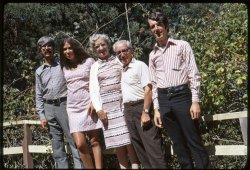
- Rest Stop: 1936
- ... from Bowman, North Dakota, in Montana." En route to Oregon or Washington. Medium-format nitrate negative by Arthur Rothstein for ... Posted by Dave - 08/17/2012 - 10:01am -
![Rest Stop: 1936 July 1936. "Drought refugees from Bowman, North Dakota, in Montana." En route to Oregon or Washington. Medium-format nitrate negative by Arthur Rothstein for the Resettlement Administration. View full size.
Seven kids in one car!I agree with you OTY. The despair these people must have known in their lives. Seven mouths to feed and bodies to clothe. I can't imagine.
Is that a AAA Trip-Tik she's reading in the car? It sure looks like one.
"I'm Bored"Along with the words in my comment title, here are some of the things my four kids said on our cross-country auto trips 45+ years ago. "He's touching me." "There's nothing to do." "I'm thirsty." "I'm hungry." "I need to use the bathroom." "Mary keeps looking at me." "I'm too hot." "He's taking up the whole back seat." "Are we there yet?" That is just a small fraction of the crabbing, even though we had books, toys, little cars, games, crayons, snacks and cold drinks in an ice chest and we slept in motels at night. Here I see SEVEN kids, not a sign of a toy in sight, everyone looks exhausted, hungry and tired and their treat will be water rationed by Dad. We cannot even imagine the despair in the lives of these people but I bet there was not one single peep from anyone about their discontent, despite the lack of Gameboys, Hot Wheels, snack-paks, cold beverages, iPods, auto TVs, etc. What strong character they had, even the tiniest of the group, and we are so spoiled.
As if all this toil and trouble weren't enoughOne of the triplets has managed to bust himself an arm. Big sister, I am sure, is quite a help to Mother, who comforts the most recent addition to the family while checking a map. That rear tire could use some air but I'm guessing that's the least of Dad's worries right now. And whoever told him Montana's the place to go must not have seen this particular spot.
Hanging water bags up front in the airflow helped lower their contents from hot to tepid, some times. Often it was useful to knock the dead bugs off before you drank, so some of them didn't join the water going into your mouth.
The Canvas water bagworks on the principle of evaporation. The bag is slightly porous and the evaporation of the water that comes through the bag cools the water. It's out on the radiator to get lots of air. And I assume as a side benefit the cooler air passing around the bag may help cool the radiator.
My Dad had one. Being born in 1889 I imagine he used them on trips. I believe the bag is still around in the house or garage somewhere. I'll have to look for it.
Wade
Water bagTo those of a certain age (like me), a familiar sight was what's sometimes called a "desert water bag" hanging in front of the radiator on passing cars. Here's a rare shot of one in actual use. I'd always assumed the water was strictly for the radiator, not human consumption.
I'm Next!I drank from one of those until 1953. Nice cold water. We always carried it out west from Texas to California and back. It was the only thing that was cool on our '38 Pontiac in the summer.
I wonder if he got to go to Disneyland when it opened in 1955? He seems to already be a fan of Mickey.
Why did they have seven kids?Because there wasn't room for eight of them in the machine.
My grandfather was about this man's age and always referred to any automobile as "the machine." I think that was rather common terminology for his generation.
Brother!This shot just makes me puddle up!
Wow, a family of nine.Let us hope they did all right.
[Papa was evidently no idler. -Dave]
The 2-Door Sedan Picturedis a 1927 Chevrolet Coach. The Coach was one of eight body styles available that year. It had a 171 cubic inch, overhead valve 4-cylinder engine and a 3-speed transmission. Chevrolet made just over 1,000,000 vehicles in 1927 and outsold Ford for the first time.
Meryl Streep lookalikeThe oldest daughter looks like she was self-consciously reaching to take off her glasses before the photo was taken. (She also bears a striking resemblance to Meryl Streep.) She must have been miserable crammed in the back of that car with five younger siblings (assuming that the baby rode up front with Mama).
Shoes for girls, barefoot boysInteresting to note that here we have a clear example of where the kids being barefoot is not an issue of poverty as we might have otherwise assumed. Seeing several barefoot boys in a cramped car in the Depression era would suggest parents too poor to provide shoes. But the fact that all the girls, even those younger than some of the boys, wear shoes proves that the boys are barefoot out of choice. Or perhaps because it was more socially acceptable or even expected for boys to run around that way but not for girls.
(The Gallery, Arthur Rothstein, Great Depression, Kids)](https://www.shorpy.com/files/images/SHORPY_8b28059a.thumbnail.jpg)
- Kingdom of Youth: 1918
- ... Due to the historic preservation laws here in Portland, Oregon, the tank had to be maintained, but not filled with water. The original ... Posted by Dave - 08/05/2012 - 5:59pm -
![Kingdom of Youth: 1918 Washington movie houses circa 1918. "Crandall's Theater, 9th & E Streets N.W." Now playing: Madge Kennedy and Tom Moore in "The Kingdom of Youth." National Photo Company Collection glass negative. View full size.
Fantastic PhotoThe building, signs, soldiers and cars all add up to a great shot for browsing.
Haunting ViewI love the Gothic Revival upper windows of Crandall's Theater. Those mysterious arches and curves are very intriguing.
Harry's JoyLots of entries in the index of Robert K. Headley's Motion Picture Exhibition in Washington, D.C. for Harry Crandall, who opened his first theater, the Casino, in 1907.
Shorpy's image is reproduced on p. 38 of Headley and identifies it as the Joy Theater (opened in 1913, "usually simply called Crandall's"); the caption also notes Tom Moore's "massive" Garden Theater to the right in the image, down 9th Street.
The Joy was Harry Crandall's springboard to the top of the Washington movie ladder. He spent $25,000 to build the Joy in what had been a four-story building that housed a haberdashery.... The floor was red concrete and sloped to the front... so that it could be flooded every night after the theater closed; it was believed that a complete flooding would keep the theater absolutely sanitary.
Seating about 450, the Joy was in operation only until 1924, when it was converted back into retail space.
Madge KennedyHow exciting to see!!!!! I was friends with Madge a few years ago!!!!!
[Madge died 21 years ago at age 96. She played Aunt Martha on "Leave It to Beaver." - Dave]
Madge & TomThe stars of this early silent drama both had extraordinarily long careers in the business lasting into the television era. Madge Kennedy actually appears in an episode of "The Odd Couple" from 1972!
How do we know that Irish-born actor Tom Moore owned that DC theater?
[Good question. Theater impresario Tom Moore and actor Tom Moore seem to have been two different people, so I zapped that from the caption. - Dave]
Black streetlightWhat is this object? Looks like a blacked-out streetlamp...
[A fire alarm call box. The globes on these were usually red. - Dave]
Let's All Go to the DentistAfter heading to the lobby to grab yourself a few snacks, make sure to check out the dentist located smack dab in the middle of all the fun. I guess if you were a dentist in 1918, you had to get your business somehow. But they don't need to worry, with "SODA" proudly displayed below the dentist's office, they'll be back.
[Right next to "Dikeman's Orange Beverage." - Dave]
Movie Palaces and Dental ParlorsNoticing the dentist between the movie theaters, remember that one of the greatest silent films, "Greed," is the story of a dentist -- who, like Washington's Dr. Fitzgerald, called his office a "dental parlor." It would be interesting to know if "Greed" played in either of these downtown theaters in 1924.
Roof TanksSeveral years ago I worked in a nine-story warehouse built in 1899. It still had a large water tank on the roof that was for the fire sprinkler system. The tank was filled by huge pumps in the basement. Due to the historic preservation laws here in Portland, Oregon, the tank had to be maintained, but not filled with water. The original pipes and pumps were disconnected. The fire system had been upgraded in the late 1950's to a newer system and most of the old copper pipes were left in place. When the building was converted to condos a couple of years ago,they pulled out all of the old pipes and left the tank on the roof.
Heads Up!Note the rooftop water tank above the Lansburgh & Bro sign. The penthouse of that building is devoted to that huge water bucket. I presume these would be filled with rainwater at no cost and supply buildings with non potable industrial water supplies.
[Interesting theory -- but how would you fill a cistern on top of a building with rainwater? (Verrry slowly.) This water tank on top of the Lansburgh department store is either regular drinking water or a standpipe tank for firefighting. Back in the day, most buildings taller than six or seven stories had penthouse water tanks, and they're still a familiar sight on older apartment buildings in big cities like New York. A lot of modern office towers have them too, although they're usually concealed. - Dave]
An early 80s ghostThis building lingered into the early 80s, though it was barely recognizable by then:
The upper floors were sheared off in 1961, and a series of low-rent tenants moved in. One of the last was an adult book store / peep show.
(The Gallery, Cars, Trucks, Buses, D.C., Movies, Natl Photo)](https://www.shorpy.com/files/images/33037u.thumbnail.jpg)
- A Fork in the Railroad: 1943
- ... up and running. This is video of switching done on the Oregon Pacific Railroad taking a loaded reefer car into the Helico spur in Milwaukie Oregon.
I would have expected that the AT&SF spring frog would have had ... Posted by Dave - 05/04/2013 - 3:05pm -
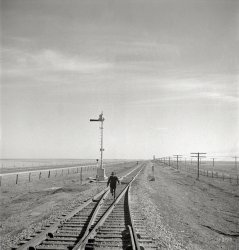
- Ford Woody: 1922
- ... product, the plywood industry was born around 1905-7 in Oregon although the Egyptians and Chinese had forms of it 3500 years back.
... Posted by Dave - 09/04/2012 - 11:11pm -
![Ford Woody: 1922 Washington, D.C., 1922. "J.C.L. Ritter -- Polli Food Products truck." National Photo Company Collection glass negative. View full size.
What kind of headlights are those?Check out the car right behind the Model T. What kind of headlights are those? Looks like a modern LED lens. Could this be some kind of gas fired light?
[You're seeing the pattern of the headlight lens. - tterrace]
Vehicle ID'sL to R:Apperson Jackrabbit(note animal on radfiator core),Ford model TT (ton truck), Packard, unknown dump truck
Lamp Covers?It's possible that those are protective lamp covers. Lots more rocks in the road and hard to find parts (no standardization of lamps yet, so probably needed to order to replace) created such a need.
Of course, in many jurisdictions these days, covers over headlights aren't legal, although you still see them, but in some sort of plastic.
More universally required these days are fenders and/or mudflaps, neither of which is on the Model T truck's rear wheels.
Classic trucksI really like these old-fashioned cars and trucks. Hard to ride on, difficult to drive, but sturdy and resistent. Those wooden bodies lend them a certain look and feel I find really attractive. And they were very recyclable - once you wrecked the truck, you could use the remains of the body in the chimney.
Yes, LensesYes, those are glass lenses on the Packard. Possibly from the Warner Lens Co. Here is a similar set on a Stutz.
Heavy Load - UnloadedThis woody must have been for lightweight goods transport - eggs, bread, etc., since the weight of all that wood is a major load all by itself. Love the trim over the side window.
Nothing personalCould these vehicles be destroyed by termites? (No offense to tterrace).
Plywood?Seems they took advantage of a relatively new product, the plywood industry was born around 1905-7 in Oregon although the Egyptians and Chinese had forms of it 3500 years back.
Note the TiresThe Ford is equipped with non-skid tires. If you don't believe me, you can read it for yourself: The words "NON-SKID" make up the siping (tread pattern).
Carpentry and axleCarpentry and axle grease...Rapture!
Ford Truck ChassisFord supplied the bare chassis, the dealer or the buyer supplied the body.
Warner LensHere is a closeup of the Warner headlamp lens introduced in 1912. Production stopped sometime in the late teens. There is an ad for the lenses here: http://the-master-craftsman.blogspot.com/2010/12/patented-in-1912-two-wa...
(The Gallery, Cars, Trucks, Buses, D.C., Natl Photo)](https://www.shorpy.com/files/images/SHORPY_29281u.thumbnail.jpg)
- Union Station: 1908
- ... the best. I always have a layover in DC on my way back to Oregon and I actually look forward to it, unlike Chicago!
Beautiful ... Posted by Dave - 07/31/2012 - 2:57pm -
![Union Station: 1908 Washington, D.C., circa 1908. "New Union Station." Idyllically uncongested. 8x10 inch dry plate glass negative, Detroit Publishing Company. View full size.
Like Dulles Airport in 1964I remember it sitting in the middle of nowhere just like this. But unlike Dulles, which was built ahead of its time, Union Station was way overdue. It was part of the "Washington Improvement" which eliminated two existing depots [including one on the Mall] and many dangerous grade crossings.
I recently found this website
http://www.washingtonunionstation.com/about.html
which is telling the whole story of Union Station. It is the dissertation of a gentleman named Bill Wright.
I wonderif anyone heading to catch a train said, "Why'd they put it in the middle of nowhere!"
Urban renewalThe foreground dramatically illustrates how the Union Station project was used to clear out the slums north of the U.S. Capitol. Then they had to decide what to do with the cleared land: one proposal would have put the Lincoln Memorial there. Today it's a park--though actually the emphasis seems more on parkING.
Bottom leftAbove the horse. Are those two coats hanging on the poles? Probably wouldn't get away with that today.
Oh my goodness!A poor title comment but I'm kind of speechless, perhaps because I've been through this station so many times; what a difference 100 years can make. For any who don't know, the finale of the movie Silver Streak was based on an actual crash into this station by a runaway 447,000 pound PRR locomotive pulling a passenger train. With brakes failed, it was headed for the Great Hall when fortunately the floor collapsed and the engine ended up in the basement. The sturdy GGI was soon back in service and no one was hurt. Gee, I wonder if Shorpy has any photos of that 1953 event?!
Just openedI believe that this was just at the time that the station opened. First PRR train was in 1908.
Missing PersonsJust realized that the statues on top of the columns at the front entrance had not yet been installed when this shot was taken (1974).
Still awesome! I'm a frequent user of Amtrak and have seen the best and the worst of their stations. Washington in my book is the best of the best. I always have a layover in DC on my way back to Oregon and I actually look forward to it, unlike Chicago!
Beautiful buildingInside and out. One of the highlights of my trip to DC a couple years ago was eating breakfast there. Looks so different without all the trees and surrounding buildings - and all those cabs and double-decker tour buses waiting out front.
Almost Lost ItWhat's really amazing is how close we came to losing this wonderful building. By the early 1970's (when the building was only 60+ years old), it had become a dingy, leaking, dilapidated, rat-infested, sadly neglected dump that was very close, more than once, to being just bulldozed so we could put another dreadful soul-deadening government office building on the site, with what remained of the so-called "train station" buried under ground somewhere. Train travel in the USA is still a shadow of what it should be (the DC-Boston corridor being one small, very modest exception), but at least we have managed to save places like this, as well as Grand Central Terminal in NY City, and South Station in Boston, along with a few scattered others.
Great photo!
(The Gallery, D.C., DPC, Railroads, Streetcars)](https://www.shorpy.com/files/images/SHORPY_4a20011a.thumbnail.jpg)
- Miriam Battista: 1922
- ... and daughter is renowned chef Amelia Hard of Portland Oregon
(The Gallery, Cars, Trucks, Buses, D.C., Movies, Natl Photo) ... Posted by Dave - 07/24/2012 - 9:48pm -
![Miriam Battista: 1922 1922. Miriam Battista, child star of stage and screen, at age 10 in Washington, D.C. National Photo Company Collection glass negative. View full size.
Ask the man who owns one!This lovely car with its porthole is a precursor to the 1955 Thunderbird, provides a luxurious backdrop for photographing the perky young child star -- who would be 97 this year! Is that a PX I see in the background? Interesting photo on several levels. Thanks, Dave!
Miriam's OeuvreMiriam appeared in 18 films between 1920 and 1935. She died on Christmas day 1980 at age 68.
Stephens Salient Six?I happened across a bound volume of the San Francisco Chronicle for May 1921. The Sunday paper always had a lavish "automobile" section with tours, car ads and testimonials. The 1921 Stephens Salient Six had overhead valves and bragged about running 600 miles on one 20 gal tank of gas - a respectable 30 mpg. They were equally proud of using "only" 4 quarts of oil on this trip - that's 150 miles per quart! No wonder busy highways were well blackened down the center of each lane.
Miriam's rideIs a Stephens touring car.
She doesn't "look like" a star ...She looks like an anonymous little girl that nobody (like me) ever heard of. Fame and celebrity are strange concepts; like bubbles inside of bubbles. Italy has stars that we'll never know or care about -- and so does every other country and culture. I hope that little Miriam enjoyed what she had while she had it because her name (and "fame") didn't survive the ravages of either time or American junk- culture.
Battista ComingApparently the press releases at the time propagated a white lie exaggerating the innocent age of Miss Battista.
Miriam Battista Coming
An interesting theatrical event will occur at Loew's Columbia theater during the week, beginning Sunday, July 16, when Miriam Battista, the 8-year-old child star of Fannie Hurst's famous picture, "Humoresque," will appear in person several times daily during the entire week. Miss Battista's personal appearances will be made in connection with showings at the Columbia of "The Man From Home," and as is is her first visit to Washington, she plans to pay several calls to prominent government officials during the time she is here. Miss Battista, who is 8 years old, has appeared with Maude Adams on the stage in "A Kiss for Cinderella," and also in Ibsen's "A Doll's House."
Washington Post, July 2, 1922
Sure looks like a PX in the backgroundIt sure looks like a post exchange in the background. Let's not forget, Washington D.C. was and still is very much a military town.
On another note, this is an extraordinary photograph. The tonality is gorgeous with full detail throughout the range, despite the harsh noonday sunlight. That photographer knew what he was doing.
BrakesNo front wheel brakes and just drum brakes on the rear wheels. I imagine these cars hardly stopped on a dime!
Did the drum brakes serve as parking brakes as well?
Is it a touring carOr a dual-cowl phaeton?
[It could be both -- if this car had two windscreens. But it doesn't. So it's not a dual-cowl anything. - Dave]
Miriam BattistaMiriam was not only a child star but the wife of the writer/photographer ?? Malone. He died in the 1940's. Her second husband was a director Lloyd Rosamond. Her brother, Willie Battista, was also a child star and performed with Helen Hayes. Miriam also is credited with theatre and television (Legend of Sleepy Hollow/Peyton Place)
Miriam BattistaMiriam's first husband was Russell Malone(y) and daughter is renowned chef Amelia Hard of Portland Oregon
(The Gallery, Cars, Trucks, Buses, D.C., Movies, Natl Photo)](https://www.shorpy.com/files/images/30293u.thumbnail.jpg)
- The Corner Store: 1932
- ... If true, pretty amazing.
Corner stores Here in Oregon (Eugene) we still have corner groceries (there's one three blocks, ... Posted by Dave - 08/05/2012 - 10:58am -
![The Corner Store: 1932 Circa 1932. "United Food Stores." Whitman's Market at A and Sixth streets S.E. in Washington. National Photo Company safety film negative. View full size.
The building's still standingView Larger Map
And it looks like the neighborhood's doing well. It's a nondescript, but nicely preserved, residential home. And there's a rather nice building to the left of the address, if you're curious. Looks original, as does most of the area.
In the Shorpy version, is that an action shot of a guy running out from between the buildings on the left? The legs seem blurred.
I'm AskingWas the United Food Stores part of a food cooperative or an association of similar merchants that were part of a buying and/or advertising group?
Beer for sale? 1926 was during Prohibition; I think the "ICE COLD BEER TO TAKE OUT" sign is a little blatant for the era...
[Beer was legal during Prohibition, as long as it didn't contain more than a certain amount of alcohol. - Dave]
This Old StoreYou can see the newer brickwork where the display window was, while the base for the window remains. Wish someone would tend to that weedy little side lot.
BoxesAs a habitual watcher, when looking at stores, one always notices the old wooden crates used prior to corrugated cardboard boxes. I've often wondered when the latter began to push the former to obscurity. Behind the fence, just to the left of the basket is what appears to be a cardboard box cut in half. Am I right? Wrong?
Everything old is new again?I miss the corner store. I wonder if environmental concerns and fuel savings might cause a turnaround soon, and small corner stores might again appear in neighborhoods?
Sure, they wouldn't have the variety that supermarkets have, but I don't think I'd miss the giant parking lots, huge crowds of people, long lines at the cash register, etc.
I also noticed the "public telephone" sign -- that's a reminder that public phones are fast going the way of the dodo bird.
[You'd use a lot more fuel distributing X amount of food to 10 small stores than you would to one big store. - Dave]
No longer a grocery todayI'm not savvy enough to put the google street view in, but there is a fantastic shot of the site there. What's interesting to note, what was in 1926 brick walkway, is today concrete, and what was concrete is now brick!
WiredThe building is still there. Although it is now a private residence. The pole sticking up from the roof is for a radio antenna.
Corner StoreWhile in elementary school back in the late 40's we had a little corner store in my Kansas town. The lady that ran the store was about 70 years old. She had all her penny candy in a big glass case where all the kids could see. Even if you had only a penny to spend she would treat that sale like it was the most important sale of the day. Each kid could take as much time as needed to select that very important piece of candy. If you purchased two or more pieces of candy she had these very small little sacks she placed your purchase in. Every child that came in her store was important and treated like a grown up customer.
Corner BusinessesThis corner is a mere two blocks south of Stanton Square (map): I walk by it all the time. One can see many private homes in the neighborhood which bear the the architectural indicators of former corner businesses. Two clues are large display windows and a street-level entrance -- most buildings constructed as houses have a few steps up.
I've searched all my usual sources in an attempt to find some information on Whitman's Market but, so far, to no avail.
Capitol Hill is said to have the largest collection of surviving Victorian buildings in the country. Several corner grocery stores survive but now the most ubiquitous corner business in the neighborhood seems to be dry-cleaners -- a testament to the importance of a professional image for workers in the Federal City.
The fence looks like the same one...If you look closely at the Google photo, the little fence surrounding the small side yard looks like the same one that was in the original. If true, pretty amazing.
Corner storesHere in Oregon (Eugene) we still have corner groceries (there's one three blocks, another 7 blocks away from me). I was surprised at how many there were when I first moved here from California in 1979. Quite a few of them are natural food stores, many also have small delis. These are privately owned, not chains (7-11). Is this so unusual in the rest of the country?
Cold Beer Next DoorI currently live in the first house to the right of the store. I knew that building used to be store, but was always amazed at how many stores were nearby. Eastern Market is two blocks away and a similar store that is still in operation on East Capitol is two blocks in the other direction.
I do think the original fence is still there, as is the fence on the right.
The staircases to the houses to the left of the store intrigue me. Those houses currently have cast iron staircases that are typical of other staircases on the Hill. I always thought those were original, but they seem to have wooden staircases in the photos. Those houses were built in the middle 1880s, so they were around 40 years old at the time of the photo. Do you think the wooden staircases were original?
Cap Hill fixer-upperThis house is on the way to my son's day care and I walk by almost every day. It has not been maintained well by Capitol Hill standards. The stairs mentioned below were not actually replaced by nice cast iron stairs later. On closer inspection two are horrible metal knockoffs and the third is a hybrid wooden steps with a period handrail.
(The Gallery, D.C., Natl Photo, Stores & Markets)](https://www.shorpy.com/files/images/31009u.thumbnail.jpg)
- School Shoes: 1921
- ... and will leave the greater LA area when I retire to Oregon -- to one of the cities for which we both pine.
Via this post, I ... Posted by Dave - 08/07/2012 - 2:10am -
![School Shoes: 1921 Washington circa 1921. "Berberich's, Seventh Street." The Berberich store at 1116-1122 Seventh Street N.W., "Washington's most progressive shoe house." National Photo Company Collection glass negative. View full size.
I <heart> DCThere's no question that the loss of these historical buildings is a tragedy. But, there are still many buildings like them all around DC.
The city went through a period where many neighborhoods were more like slums and the houses were is such great disrepair that it would have been prohibitively expensive to renovate them.
In fact, when tax relief for investors seeking to renovate houses in DC was enacted, we all eventually benefited. That's where the "live in the house for 2 years and pay no capital gains on the profit (up to a certain amount)" comes from.
And to truly renovate a house like one of these in some cases required hollowing out the whole thing and starting from scratch. You could save the carved moldings, but many of the houses predate wiring, ducting, etc. And the roofs would be in bad shape allowing for water to get inside and the mold problem would be terrible.
They almost tore down the Willard Hotel in the 80's for gosh sakes! It is one of the most beautiful architectural structures in the city! (Not to mention a very nice hotel.)
And there is a "feel" to the city that you can only get by going there. These pictures, for me, are an enhancement. My father worked in the city for over 35 years--my parents met there. I was married there. The bustle of the traffic, the gravity of the stone granite federal buildings, the many different periods reflected in the architecture are a treat to the senses.
Are there buildings that are basically ugly brick boxes? Yes. There are also interesting buildings from the 60's and 70's.
Personally, I love the city in winter. Maybe because I was married there in the winter at St Dominic's and honeymooned at the Shoreham. But, it's not like New York or really any other city.
For one thing, the buildings tend to be shorter -- especially in the Federal Triangle.
And visiting the various museums is a real treat. There are parks here and there that kind of surprise you--beautiful parks. And the area by the zoo is old and beautiful. The college campuses are also gorgeous.
There really is more than "seeing" DC. It is an experience.
These pictures enhance my experience of the city. And while I mourn that many of these buildings are no longer there, there are plenty that will be there long after all of us are gone.
Mme. BelleMme. Belle is not the first palmist to appear at Shorpy. We have previously seen signs for Mme. LaBey and a glimpse of Mme. Trent.
50c MME. BELLE 50c
Egyptian palmist, gives true advice in business, love, health, and family affairs. Confidential readings daily, 10 a.m. to 8 p.m. 1124 7th st nw., between L and M sts.
Advertisement, Washington Post, July 22, 1921
ManageableI miss the days when cities were manageable. When your neighborhood had the butcher, the baker, the shoe and clothing stores. You could walk to them, or take the trolley. I grew up in San Francisco in the late 1930s-40s, and these photos remind me so much of what was there. Of course in those days, there wasn't so much to buy, and we didn't "need" to buy so much.
There's Nothing There Anymore ...Except "modernization" and general, all-round nothingness. One of the real downsides to visiting this website is that, although I've never been to Washington, D.C., I cannot think of any reason to ever want to go there. I feel like I'm seeing the best of it here -- and Google Maps is filling in the rest of the sad, sorry tale.
Progressive ShoesAt last, a really progressive shoe purveyor, a welcome relief from the myriad reactionary footwear specialists!
Lower left corner...I love these little glimpses - the man at the truck looking at the blur of a passing woman on the sidewalk!
The "scientific" palmist the only window open with fluttering curtains, the flat top windows on the second floor and the arches on the third, in both buildings, and the sunburst iron railing design, et cetera.
I wonder why so much of Washington, but still they are interesting!
[Aren't they indeed. - Dave]
Today, the Convention CenterView Larger Map
Shoe Store Post OfficeThose were the best of times. One simply cannot find a good shoe store/post office anymore.
Lovely buildingBerberich's may have been an everyday shoe emporium, but its building was delightful. It's amazing the detail that brick and stone masons of the day put into their art (and architecture) for simple, business buildings that were torn down later without a thought or a care. I liked the multitasking the photo reveals, too: Shoe store and postal station. Please note that Mme Bell was a "scientific" palm reader!
Mme BellI wonder if "Mme Bell, Scientific Palmist," knew that her office sign would appear on Shorpy someday.
What a marketing move!Go to the Post Office and see the latest in shoe wear. You know you can't tell your wife not to go to the Post Office!
ManageableAnon sed: "I miss the days when cities were manageable. When your neighborhood had the butcher, the baker, the shoe and clothing stores."
There are many of those smaller, manageable cities thriving still across our wide land. I share your sentiment and will leave the greater LA area when I retire to Oregon -- to one of the cities for which we both pine.
Via this post, I consider the trout in streams neighboring that manageable city to have been formally warned.
Berberich's
The Fortieth Birthday of Berberich's Shoe House
Started with Nine-Foot Front, Now Has 12,000 Square Feet Floor space.
...
Just forty years ago Robert Berberich opened a small store at 1118 Seventh street northwest. This store was only nine feet wide and less than thirty deep. A large part of the business done at first was made-to-measure work. Mr Berberich, who was an expert shoemaker, fitted and sold to the best people of that period their boots. He soon gained a reputation for style and high quality work which has followed him even to this day. Although he is now retired and leading a quiet dignified life, he watches with much pleasure the prestige which his two sons, who have succeeded to the business, are enjoying, knowing that they are reaping the benefits of the lucrative business of which he was the father.
From that small nine-foot front beginning the firm has grown until today it occupies 12,000 square feet of floor space of which 4,000 was recently added. The little nine-foot store was in a little frame building, but this was then one of the landmarks of the city, and was known as Berberich's - Seventh street being the busiest thoroughfare in Washington. Mr. Berberich was one of the pioneer merchants of this thoroughfare. Taking a just business pride, he soon outgrew his cramped quarters, and owing to this continually growing business he was forced to a larger more modern store.
He then bought the property at 1138 Seventh Street, this being in 1877, only nine years after the business began. At the time Mr. Berberich purchased this place it was a small frame building, set on a steep bank. After bringing this down to street level, he built upon the site a three-store brick dwelling, 25 feet front, at that time considered a handsome modern building. Here with 1,500 square feet of floor space and his store fitted up in the best manner, his trade continued to expand. ...
In 1902 the firm, which by this time included the two sons, Robert J. and Joseph A., purchased the property at 1116-1118-1120 Seventh street, of which the original store was a part. On this site was erected the handsome building which no adorns the neighborhood, and is the best appointed of the modern shoe stores in the city. This new store was fitted up in the most modern way, the best grade of oak being used for shelving with quartered oak and grill work decorate them in a proper manner.
In the rear of the store are three of the largest mirrors in Washington, which take up the entire back wall and give the store the appearance of being several hundred feet deep.
...
Only a few months ago they added the property adjoining them on the north, numbered 1222, to their store. This now gives them from 1116 to 1122, a total frontage of 60 feet.
[Article goes on to detail the many brands of shoes carried by Berberich, many of them under exclusive contract for Washington: Buster Brown Blue Ribbon Shoes, La France Shoe, Selz "Royal Blue," Burt & Packard "Korrect Shape," and American Girl Shoe.]
Washington Post, Sep 20, 1908
In 1927, Berberich's closed their store at 1116-18-20 Seventh street and relocated to Twelfth and F, northwest.
[And filed for bankruptcy in 1931. - Dave]
The Old MathIf this business opened 40 years before 1921, then it opened in 1881. In the article below, however, it states that "in 1877, only nine years after the business began." If the 1877 date is correct, than the company opened in 1868. Am I missing something here or do we have a case of "alternative" math?
[You're missing something. The article is from 1908, not from 1921. - Dave]
Robert Berberich and Son’s Shoe EmporiumThat’s my great-grandfather’s shoe business there. Amazing, what an incredible
historical building and era…
Carole
(The Gallery, D.C., Natl Photo, Stores & Markets)](https://www.shorpy.com/files/images/30356u.thumbnail.jpg)
- Calvary Presbyterian: 1948
- Portland, Oregon, 1948. "Calvary Presbyterian Church." Completed in 1882 and now known ... Posted by Dave - 06/13/2022 - 2:57pm -
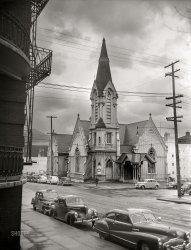
- In the Beans: 1939
- August 1939. "Marion County, Oregon, near West Stayton. Father and children came from Albany, Oregon, for a season's work in the beans." Photo by Dorothea Lange for the ... Posted by Dave - 07/01/2015 - 8:32pm -
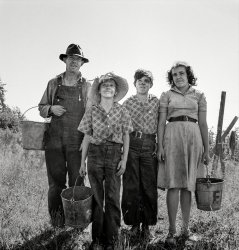
- Dead Ox Flat: 1939
- ... basement dugout home. Dead Ox Flat, Malheur County, Oregon." View full size. Photograph by Dorothea Lange.
Good Methodist ... Posted by Dave - 09/08/2011 - 5:17pm -
![Dead Ox Flat: 1939 October 1939. "Mrs. Hull, in one-room basement dugout home. Dead Ox Flat, Malheur County, Oregon." View full size. Photograph by Dorothea Lange.
Good MethodistAnd I'm willing to bet she sat at that piano every Saturday night, turned that hymnal to p. 239 and played "Nearer My God To Thee" thrice, singing all three verses as she played.
Love that smile!
Denny Gill
Chugiak, Alaska
"Call for Philip Morr.....is"Handsome looking woman, did she smoke Philip Morris cigarettes? A couple of observations: If she is "Mrs" Hull, where is her wedding ring? And I found the lace pattern on her shoes to be quite interesting ... I don't believe I've ever seen shoes that lace like that.
[Mrs. Hull, a Quaker, had a husband and a daughter. Wedding bands generally are not part of the Quaker wedding ceremony. - Dave]
Re: Call for Philip MorrisThat's not the Philip Morris boy. It's a McCall's magazine cover.
Handsome, indeedAnd since she's a Quaker and I belong to the Church of Christ, we're practically cousins!
We could belt out every verse of "Nearer My God To Thee" and all the old hymns I used to sing with my grandparents as she played the trusty old piano behind her...
And afterward I'll bet she'd serve coffee and the best pie in three counties.
"Old" photosJust an aside ... This photo from 1939 is not really all that old; Mrs. Hull could still be very much alive and certainly if she had children they also might be alive. Now none of the comments below are what I'd call critical or rude, but they are, shall we say, poking more than a bit of fun at this subject. This raises for me some interesting questions about *old* photos and how we react to them and comment on them. This issue has occurred to me before when reading local news stories about people and events that on first glance feel so long ago, but really are not and concern people still very much alive and kickin' (who themselves read news stories and look at blogs). I love history, esp 'social history' and local history, and find it pertinent now and then to remind myself that what can feel like ancient history to some is just a handful of years ago to others...
[You might want to check your math. She looks to be around 50 years old. Even if you say she's 40 in this 1939 photo, that would mean she'd be 108 now. - Dave]
Those shoesThey're called "gillies" and are styled to look like they're missing the tongue. The first time I came across the term was in Harriett the Spy - Ole Golly's mother wore them.
I like to watch the History Channel, but lately, it's all reruns.
[And what about these shoes. - Dave]
Dead Ox FlatMy grandmother was the schoolmarm at Dead Ox Flat at about that time. Most likely taught Mrs. Hull's children in a one-room schoolhouse.
My lands!Quite handsome, and must have been quite a looker in her younger days. I love this site, thanks so much for devouring most of my recent spare time since I found it!
(The Gallery, Dorothea Lange, Great Depression)](https://www.shorpy.com/files/images/8b35115u.thumbnail.jpg)
- Dazey Boy: 1939
- ... going to feed the pigs. Homedale district, Malheur County, Oregon." Medium-format nitrate negative by Dorothea Lange for the Farm Security ... Posted by Dave - 09/05/2012 - 7:10pm -
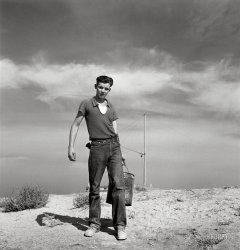
- Pop Start: 1925
- ... named Cincinnati, and the only one that ever existed in Oregon was a community from 1844 - 1856 (renamed Eola).
The scale on the ... Posted by Dave - 05/17/2014 - 11:58pm -
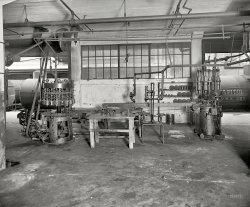
- Church Street: 1911
- ... to that effect. It happened in the 1980s in Eugene, Oregon, I know. By the time we moved, they had begun to reopen the streets to ... Posted by Dave - 02/18/2014 - 1:39pm -
![Church Street: 1911 Burlington, Vermont, circa 1911. "Church Street north from Bank Street." 8x10 inch dry plate glass negative, Detroit Publishing Company. View full size.
Same scene todayChurch Street is a pedestrian mall.
View Larger Map
Sunday, Sept. 3The day of the Eagles excursion to Montreal. The LOC database dates the photo between 1910 and 1920. That would be either 1911 or 1916. Hence, I suppose, Dave’s “circa” in the caption.
Church St. revisited..As a former resident, I found this particular photo quite enlightening. I worked at several bistros and bars on this street in the 80-90's, Leunig's in particular on the corner of Bank and Church. But the details here are incredible by use of the enlargement to pan in and out. So what is the deal with he ornamental light-right upper on the pulley system for lowering/raising? Oil-kerosene? Pretty unique as is the unknown trolley system, wow. Thanks Shorpy, will be ordering a few of these to take back to Vermont. Cheers! PS, more Vermont pics please??? Chips Hanson/Stowe
[Carbon arc lamp. -tterrace]
Where's the pool table?Those knickerbockers look like they're buckled BELOW the knee!
Anyone here?Sometimes these pedestrian malls kill commerce in a downtown. Customers can't park near stores, or something to that effect. It happened in the 1980s in Eugene, Oregon, I know. By the time we moved, they had begun to reopen the streets to traffic.
Street lights in the rainAnyone know how they kept the street lights working in rain? Looks like the connections weren't real weatherproof.
Stanley SteamerI'm going to go out on a limb and say that is a 1909 Stanley parked at the curb.
Not SureWhat the heck is corset parlor?
You are surethis scene is from Down East by the Moxie sign on the store to the left.
Stanley SteamerYippee!!! Too cool, the Stanley Steamer sitting at the curb definitely dates the photo before 1915; the Stanley was a pretty unusual sight even back then.
[There's no reason an elderly Steamer couldn't be parked at the curb any time after 1915, unless they suddenly dematerialized when they got to be a few years old. - Dave]
Great photoI already posted but this photo is packed with great detail of the Edwardian period of transition from old to modern --the stately matron on the left, but a frisky young girl running up the street (kids will always be kids; timeless) --the blocks of ice in the back of the ice wagon, --the quiet but powerful Stanley Steamer with the well dressed lady waiting patiently in the back seat (a "lady" would never drive) while we know that the Stanley had the pilot-light keeping the steam pressure up; starting a Stanley from cold was a 20-minute process
--the streetcar conductor oozes presence and confidence
--the streetlight-on-pulley to lower for maintenance. Too cool.
Leunig's locationWe lived in South Burlington, VT for almost 30 years. Leunigs actually was at the corner of Church and College Streets.
(The Gallery, Cars, Trucks, Buses, DPC, Stores & Markets, Streetcars)](https://www.shorpy.com/files/images/SHORPY_4a24278a.thumbnail.jpg)
- The Fake: 1957
- ... term Tiger Drug Store in Stillwater).
Rah! Rah! II Oregon State Beavers!
(Kodachromes, LOOK, Sports) ... Posted by Dave - 09/24/2014 - 4:16pm -
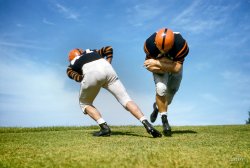
- Public hanging
- ... a cigar box that was tossed into a dumpster in Portland, Oregon. I have no idea of the history. View full size.
Maybe around ... Posted by William - 09/20/2011 - 8:51pm -
![Public hanging I found the negative in a cigar box that was tossed into a dumpster in Portland, Oregon. I have no idea of the history. View full size.
Maybe around Denver?I googled the name, came up with very little except the name showing up twice in the undigized list of the Denver Public Library. There is a town in Colorado called Buena Vista.
Newspaper article Chaffee County Times, Colorado
In 1888, the first legal hanging was held in this area behind the courthouse. This was the hanging of Nicolo Feminella, who was convicted of the murder of a fellow miner.
Some historyHere is a link to a story that mentions this event in passing: http://www.chaffeecountytimes.com/main.asp?SectionID=7&SubSectionID=7&Ar...
"In 1888, the first legal hanging was held in this area behind the courthouse. This was the hanging of Nicolo Feminella, who was convicted of the murder of a fellow miner. A lot of history has evolved in this area and in the old McGinnis Gym."
Building on the old gym news story...The Chaffee County Courthouse and Jail Buildings are now a museum.
http://www.buenavistaheritage.org/Page.aspx?PageID=2355
at the bottom of the page:
The large room at the top of the stairs was once the heart of this venerable old building. This courtroom was the scene of many exciting cases. The fate of Nicolo Ferminello, an Italian accused of stabbing a man to death, was decided here. He was sentenced to die for his crime and his is Chaffee County's only "legal" hanging. He was hanged at the back of the jail complex. The room, which is now available for rental, has the original judge's bench and chair.
notice the use of scare quotes around legal hanging...
Big!Seems like an awfully big and heavy structure for a single hanging. Surely the forces sufficient to snap his neck would not have been anywhere near sufficient to need all those 2x8s, braces, and so on. Of course, lumber was cheap....
GallowsIt is a counter weight gallows. The condemned was led to the rope at ground level. A very heavy weight was released jerking him into the air.
In this picture the man is being lowered by raising the weight out of the picture to the left. Some spectators are watching this. On the left side of the picture you can see the tought rope leading down to the weight.
[Little known fact: only educated ropes were used for hangings.]
Cigar box?You found this photo in a cigar box in a dumpster??? That's odd...that photo might be worth something. I would keep it and frame it, it's a piece of history.
Another version of the history of this hanging...Source: coloradodefenders.us
This was the 24th execution in Colorado:
NICOLAI FEMENELLA (a.k.a. Mike George). August 23, 1888. Buena Vista (Chaffee County). W-W. Hanging/Broken neck. An Italian immigrant, Femenella was convicted of murdering Irishman William “Pat” Casey, who, like Femenella, was employed as a railroad section hand in the city of Granite. The murder resulted from a quarrel between several Irish and Italian immigrants about the men’s different ethnic heritages. After his conviction, Femenella began to claim that he killed in self-defense, a plea that may have saved him from the gallows had he originally used it at trial.387 Governor Alva Adams deferred the execution on three occasions. “According to prevalent opinion here Femenella has received more consideration than would be accorded to the majority of lifelong citizens in this community.”388 Approximately seventy-five people were admitted to the jail yard to witness the hanging, and a “large crowd” mingled outside the jail fence. He was hanged with rope left over from that ordered from a St. Louis company to hang Andrew Green (q.v.).389
(ShorpyBlog, Member Gallery)](https://www.shorpy.com/files/images/Hangin.thumbnail.jpg)
- Lost Dog: 1939
- October 1939. "On U.S. 99 as it continues through Oregon. Lane County, Williamette Valley." Back in the day, this doggy sandwich ...
Waymarked The location was Cottage Grove, Oregon. The local library has a file on the stand stating that it was built in ... Posted by Dave - 12/04/2013 - 8:08pm -
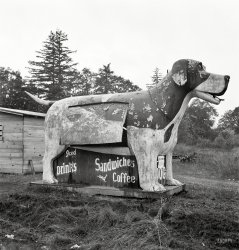
- Drunken Ducks: 1925
- ... "Crazier than a peach orchard boar." My dad, born in in Oregon in 1909, often used this old-timey expression to describe obnoxious ... Posted by Dave - 12/30/2008 - 12:02pm -
![Drunken Ducks: 1925 Sept. 5, 1925. "Intoxicated ducks at 611 Yon.[?] Street." This one's a mystery to me. National Photo Company Collection glass negative. View full size.
Mystery Solved?It appears to be a scene of the aftermath from a prohibition-era raid. Note the remains of the barrel (hoops and staves) behind and to the right of the ducks. The one duck looks like it's getting a sip of the hooch that came from the busted barrel.
Prohibition ViolatorsLooks like the cops busted up a speakeasy or a covert still the night before. The broken barrel is a good clue, and the ducks are drinking from the pool of whatever was in the barrel. And 1925 was in the middle of Prohibition.
My grandfather tells tales about ducks and geese just gobbling up half-rotten berries and getting intoxicated off them back in Yugoslavia.
A TheoryEither these two flappers were observed leaving their favorite quackeasy, or they were drinking from a puddle of hooch.
Birds are often drunkWe had several fruit trees at one time, pears, apples, peaches and cherries, and when the fruit would fall on the ground and ferment in the hottest months of summer, some of the birds went nearly berserk to get ahold of the intoxicating sour mash on the ground. They could not even walk straight after indulging excessively and would even become lethargic (squirrels also). As kids, we found it quite amusing.
Beer Baron"Where'd ya cop the hooch, rummy? Is some blind tiger jerking suds on the side?"
"Um, yes?"
Yon.[?]Yon. short for Yonkers, maybe? There is a Yonkers Avenue.
[This is in or near Washington, D.C. "611 Yon" might be an erroneous transcription of "Kenyon." There was also a raid around this time at 607 I ("Eye") Street. - Dave]
You Who?I'd guess that the address is U (You) Street in DC, on a block that has seen a good many more raids since 1925. (The 600 block of U is the western end of that fabled Washington street, and was near the old Griffith Stadium featured in several Shorpy photos.)
[Brilliant! That must be it. - Dave]
Guzzling it (eider)downOne of the funniest things I ever saw was a PBS documentary years ago of animals in Africa who couldn't get enough of fermented fruit available at a certain season: all of them - elephants, antelope, birds of all kinds, zebras, giraffes, you name it, were all staggering drunk.
Eye Street HypothesisWhile respectfully not negating GlenJay's "You [U] street" hypothesis, I will throw this additional information into the mix. The following account of a moonshine raid is the nearest match I can find in the Post archives. The address of this incident, 607 I street, is curiously close in number to the photograph: #607 is two doors down from #611 and events in a rear alley could easily overlap the addresses. Additionally, I street is often spelled "EYE street," potentially being transcribed as "Yon."
There remains, however, a date discrepancy of several days. Numerous explanations are possible:
Simple transcription error.
The National Photo photographer was tardy arriving at the scene and discovered the ducks on the 6th day of their bender.
The date corresponds to the day the plate was developed.
Also unknown to me is how often bootlegger raids occurred in D.C. at this time. Would every one be reported in the newspaper or only those with additional juicy details such as the offender ramming a police car?
Raid On I Street Nets 70 Gallons
Arrest Made; Burlingame Nabs Driver
Ramming His Pursuing Car.
Capt. Guy E. Burlingame and his "flying squadron" swooped down on the premises at 607 I street northwest yesterday, where they found more than 70 gallons of alleged "white whisky," 13 bags of mash and a complete outfit for making liquor.
Anthony Consoli, 21 years old, who gave the above address, was taken to the Sixth precinct and charged with manufacturing and possession of liquor.
Burlingame and several of his men escaped injury, except for a shaking up, when an automobile they were pursuing in an alley between Fourth and Fifth, near N street northwest, yesterday rammed the police car.
John Carter, colored, of 93 L street northwest, driver of the car, was charged with transporting and illegal possession of twelve gallons of corn whisky.
Washington Post, Sep 1, 1925
Ducks are Notorious PikersNever heard anyone say, "Drunk as a Duck."
But Skunks are another matter.
Fermented fruitAmarula, a cream cordial from South Africa, has a label with elephants and the marula fruit. Elephants and other animals enjoy getting tipsy from eating the fermented marula.
Tipsy Fauna"Crazier than a peach orchard boar." My dad, born in in Oregon in 1909, often used this old-timey expression to describe obnoxious persons of either gender who could not hold their liquor, the inspiration being the wild pigs from the woods that would raid the orchards to feast on the fermented fruit under the trees. Since we owned a businessman's-lunch restaurant and bar in the hard-drinking 1950s, even our waitresses picked it up from him and started using it back in the kitchen where the customers couldn't hear them.
(The Gallery, Animals, Natl Photo, New Year)](https://www.shorpy.com/files/images/14337u.thumbnail.jpg)
- Full Service: 1940
- ... states where they still pump the gas for you. Residents of Oregon and New Jersey don't have self serve pumps even now. Of course the ... Posted by Dave - 05/23/2012 - 10:59am -
![Full Service: 1940 May 1940. "Wiping off windshield at service station in Cairo, Illinois." 35mm negative by John Vachon for the Farm Security Administration. View full size.
PremlarAs a high school kid, I worked at a gas station for a couple years. We initially had the bow ties, but no caps. Then that sort of went by the wayside.
We had one regular customer who ALWAYS wanted us to 'fill it up premlar'. I never was sure why. Did he want half a tank each of premium and regular? We just gave him premium and he was happy with that.
KaroCairo is the southernmost town in Illinois. The folks I was working with there explained that I should pronounce the name the same as "Karo" syrup.
Full serviceYou don't get that anymore. I worked the full service island at a Mobil station when I was in high school. Check under the hood for you ma'am? Left rear looks a little low. Ah, the days of sell-ups. I even got to pump Ethyl.
WindshieldI wasn't around in 1940, but I am old enough to remember "full service." It always seemed that the pump jockey was able to clean off my windshield better than I ever could, even to this day. No streaks! Wonder what kind of magic solution they used in that pump spray bottle?
Can I Get 50 cents Worth Please?I'll bet he has the chrome change dispenser on the front of his belt. Those things were murder on paint jobs back then if the guy wasn't careful. Don't ask me how I know.
Memories of Dad and the gas stationThe stop for gas was a ritual that fascinated me. Loved ding-ding as the car drove over a sort of hose. Dad got out of the car, conferred with the attendant, and asked for a fill-up. The windows were cleaned, tires and oil checked, etc. Everything in place, we drove off.
Me tooWorking at a gas station I pumped the gas, cleaned the windshield, checked the tire pressure, opened the hood, checked the oil and fan belt condition/tightness and filled the window washer tank if the auto was so equipped. Changing tires with an old manual bead-breaker was not my favorite job though.
Who's Ethyl?!?!?My kids looked at me like I was crazy (shut UP!) when I said that my FJ Cruiser would only run on Ethyl.
Glad someone else remembers the term!
--Jim
Full Service Gas still exists at no extra costThere are two states where they still pump the gas for you. Residents of Oregon and New Jersey don't have self serve pumps even now. Of course the people who pump the gas don't have sparkling white uniforms with caps, don't do it from globe top dispensers, never have any leaded gas on hand, let alone HiTest or Ethyl, and don't charge 26 cents a gallon any more.
1940 Plymouth?I think the instrument cluster matching what we can see of the posted car gauges is a 1940 Plymouth.
[Wow! -tterrace]
Sinclair Service AttendantGrowing up we had a Sinclair service station near us and I was always intrigued with the dinosaur logo they used. I see they are still in business but I haven't seen a service station in our area for years.
My first real jobAround 1976,I hired on as a mechanic at a local Mobil gas station. I was taught to check under the hood, check the tires, wash the windshield and notify the customer if the oil was low or dirty, and steer them to an empty bay if we had one. The station did not allow self-serve, and this was about the time that self-serve was the majority. We were one of the last full serve stations for many miles. I made a whole $2.10 an hour doing tuneups, carb repair, engine overhauls, transmission overhauls, clutches, and I also used the old manual tire machine. In trade school, they required you to learn how to use the antique, because some of us would be hired at a shop that still used that as their primary tire changer. The reaosn I got the job was because I was fluent with the antique and impressed the boss that I could change a tire faster than he could (a 70 year old man with arthritis)
(The Gallery, Gas Stations, John Vachon)](https://www.shorpy.com/files/images/SHORPY_8a06350a.thumbnail.jpg)
- Two Forks: 1939
- October 1939. "Hay forks. Northern Oregon farm. Morrow County, Oregon." View full size. Medium-format nitrate negative by Dorothea Lange ... Posted by Dave - 08/15/2008 - 9:52pm -
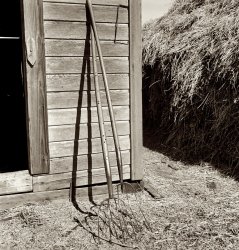
- Federal Auto: 1917
- ... The Court Street Dairy Lunch still exists in Salem, Oregon. A luncheon based on dairy products must have been considered ... Posted by Dave - 08/07/2012 - 10:18pm -
![Federal Auto: 1917 Washington, D.C., circa 1917. "Federal Auto Supply Co., Pennsylvania Avenue." National Photo Company Collection glass negative. View full size.
The legless beggarDid the photographer mean to make a social statement with this picture? Probably not, considering racial attitudes back then. But a legless black beggar one door away from a good hot 25-cent meal sure hit me between the eyes.
Dairy LunchI always assumed, when I saw "dairy lunches" mentioned in old novels, that it meant the same thing in gentile circles that it does in Jewish ones -- that is, a restaurant that doesn't serve meat. Looking at this photo, I'm getting the idea that I might have been wrong about that. Either that or this is the craziest kosher restaurant ever! So what is a dairy lunch, anyway?
[The "dairy lunch room" came to prominence in the late 19th century, offering fast food for white-collar workers. The name signified "not a saloon" as much as it did the contemporary fad for malteds, shakes and ice cream. Dairy bars found new popularity with the rise of the temperance movement and advent of Prohibition. A lot of these places were former taverns. - Dave]
LunchBeen a while since I've had liver and onions for any meal let alone lunch. I'll spring for the small steak for man in need at the drug store. Any idea what the hose near the curb might have been for?
Today's QueryAnyone know where I can get some hot rolls?
InterchangeabilityHm. Ford Parts next door to Ford Lunch -- maybe I don't wanna know.
Eh?477 would be right about where the Canadian Embassy is now.
A Legless VeteranGiven the dating of the picture as "circa 1917" I think it's reasonable to suppose that the legless man might be a World War I veteran injured in the War.
[He's an old man, so he would not be a WWI vet. - Dave]
The Dairy Lunch todayThe Court Street Dairy Lunch still exists in Salem, Oregon. A luncheon based on dairy products must have been considered particularly healthsome.
Re: Eh?Unless it was 477 Penn Ave SE, which would put it behind the capital about halfway to Eastern Market. Some surviving buildings in that neighborhood are reminiscent of these buildings.
[This is 477 Pennsylvania Avenue Northwest. - Dave]
Dairy Lunch ReduxOh, of course! Duh! Thank you! To differentiate themselves from the "free lunch" offered by bars, as a respectable eating place. I suppose the "family lunch" places we've seen advertised in some photos had the same idea.
Tire TrollopThat appears to be the Kelly Girl in the left door. An infamous ad from 1910 showed her sitting on a Kelly tire and exposing her ankles! It was a huge controversy.
(The Gallery, Cars, Trucks, Buses, D.C., Natl Photo)](https://www.shorpy.com/files/images/32857u.thumbnail.jpg)
- Red Crown Gasoline: 1927
- ... At Bray, a dot on the map in Siskiyou County up near the Oregon line.
Balanced gasoline Nebraska, 1921.
Law & Order, ... Posted by Dave - 10/23/2014 - 12:17pm -
![Red Crown Gasoline: 1927 Northern California circa 1927. "California State Automobile Association Official Mechanical, First Aid and Towing Service Station." Offering Emergency Road Service and Red Crown Gasoline. 6½x8½ inch glass negative originally from the Wyland Stanley collection of San Francisciana. View full size.
DANCE!At Bray, a dot on the map in Siskiyou County up near the Oregon line.
Balanced gasolineNebraska, 1921.
Law & Order, Siskiyou County I believe that area is favored by the FBI for relocating newcomers into the Witness Protection Program.
Car (formerly) IDJordan. The Jordan emblem has a small arrow head pointing down on a white background, qv.
Fill 'er up? Those glass-cylinder pumps may have their charms, but it's worth considering that they made it unworkable for a motorist to say "Fill 'er up" because that would likely leave the fuel level in the glass somewhere between graduations, necessitating guesswork as to the quantity delivered -- as well as confusing matters for the next customer. And, of course, ordering fuel in even-money amounts (as opposed to by-the-gallon) was out of the question.
[Or maybe not. Below, from TheOldMotor.com - Dave]
The measuring sticks inside started out with zero gallons at the very top, where the cylinder's overflow was set, and the numbers progressed by gallons to the bottom of the glass. The customer paid for the displaced gallons by reading the measuring stick on the inside of the cylinder. The cylinder was then topped off at zero for the next customer. At closing time, fuel in the cylinder was drained back into the underground tank.
AAA / CAAHere in Canada, our affiliate with AAA is CAA, and I work for the Alberta CAA (Alberta Motor Association) formed in 1926. This is our 1926 tow truck, used in a lot of parades.
Red Crown tire valve capsIn the early 1950s Red Crown service stations gave or sold red tire valve caps in the shape of their Red Crown. I really, really, really wanted two for my bicycle, unfortunately I could never find a service station that had them. One of life’s bitter disappointments.
Red Crown Valve CapsNever too late to get some.....
Those were the daysWhen gas stations were rigged liked sailboats. I am trying, unsuccessfully, to understand the purpose of the pole/pulley/cable rig on the side of the building, which apparently opens a second story window.
[The pulley is exactly like those on the poles at the end of my mother's washlines, each of which extended from a window, one in the kitchen, one in the bedroom. -tterrace]
Thanks, tterrace, makes sense to me now.
(The Gallery, Cars, Trucks, Buses, Gas Stations, W. Stanley)](https://www.shorpy.com/files/images/SHORPY-141023-0003.thumbnail.jpg)
- Rent-a-Horse: 1865
- ... of hay... Why do I feel like I'm getting ready to play Oregon Trail?
Northern Liberties Fire Co. Washington also had a ... Posted by Dave - 09/12/2011 - 6:02pm -
![Rent-a-Horse: 1865 April 1865. Washington, D.C. "John C. Howard's stable on G Street between 6th and 7th, where John H. Surratt kept horses before leaving town on April 1." From photographs pertaining to the assassination of President Lincoln, April-July 1865. Wet plate glass negative, photographer unknown. View full size.
Howard's RestaurantI'd be a little hesitant about ordering a steak.
Archie's gangThat's a great brick arch. No other support except for brick and mortar. Good luck finding one of today's "masons" who could do that.
So shiny and so new!What really excites and impresses me about this photo (and many others on this site) is how it allows me to "view" 1865 as being "new." Look at how bright that paint job on the arch is -- as if it were completed only yesterday! And that brickwork, too! Just mortared last week! Like many people, I'd always thought of "the past" as being faded, drab and brittle -- but not here; it's almost like stepping through a portal into the real past as opposed to the past we're left imagining. I realize that I'm merely restating a very worn-out cliche, but it's true in this case: no broken-down and crumbling cemeteries that leave us feeling creepy or faded Daguerreotypes that distance and alienate us from the subject; just a bright, shiny, new paint-job that reminds us that "life" is always ongoing and "in the present." This photo is wonderful. Thanks for posting it.
Gone With the WindLooks like this location is now occupied by the Verizon Center. Yeah, times change, but ...
Northern LibertiesThe sign on the hose cart identifies it as an import from Philadelphia. The industrial district of Northern Liberties supplied essential tools and weapons to the Union Army during the Civil War. The Northern Liberties Fire Bucket Company, established in 1821, was one of Philadelphia's first firefighting outfits. It was reorganized as the Northern Liberties Hose Company in 1828.
Hose wagonThat shiny wagon, is it a hose wagon for fire fighting?
Does it have anything to do with Lincoln's funeral?
Is the name plate readable on blowup?
So many questions!
[It is a Northern Liberties hose cart. - Dave]
I'll have two axles and four tons of hay...Why do I feel like I'm getting ready to play Oregon Trail?
Northern Liberties Fire Co. Washington also had a Northern Liberties Fire Co. In 1840 the Northern Liberty Fire Company was organized. It was located at 8th & K Streets N.W. until 1856 when they moved to 6th Street and New York Ave. N.W. until they disbanded in 1858. On September 1, 1856 By-Laws and Regulations were adopted for the governing of the different volunteer companies. The following is quoted from those By-Laws: "Districts are hereby assigned to each of the fllowing companies, viz: Union, Franklin, Northern Liberties, Perseverance. Annacostia, and Columbia. And on the occurrence and during the continuance of a fire, it is made the duty of that company in whose district the fire shall occur, to exhibit their lanterns on their apparatus, and which shall be considered the rallying point for the standing committee. The Districts comprise the following sections of the city: For the Union, all that portion of the city lying in the First Ward. For the Franklin, the Second Ward and that part of the Seventh Ward between 10th Street west and the Potomac River, For the Northern Liberties, the Third and Fourth Wards north of the line of F Street. For the Perserverance, the Third and Fourth Wards south of the line of F Street, south and that part of the Seventh Ward lying between 10th and 4 1/2 Streets, west. for the Columbia, the Fifth Ward and that part of the Seventh Ward east of the line of 4 1/2 Street, west. For the Annacostia, the Sixth Ward. The apparatus was hand drawn, the horse was used in parades.
(The Gallery, Civil War, D.C., Horses)](https://www.shorpy.com/files/images/04204a.thumbnail.jpg)
- On the Road: 1936
- ... and drought-stricken area for a new start in Oregon and Washington. Make about 200 miles a day in Model T Ford." Our second ... Posted by Dave - 08/22/2012 - 7:43am -
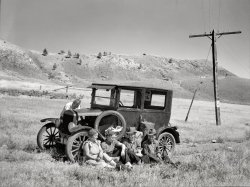
- On the Road: 1939
- ... plant. Twenty-five year old itinerant, originally from Oregon. "On the road eight years, all over the country, every state in the ... Posted by Dave - 07/30/2012 - 2:43pm -
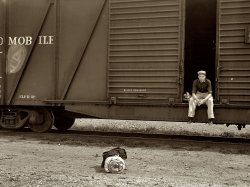
- Market Street: 1904
- ... There are a few remaining buildings here in Portland, Oregon, which have faces carved into them. When did our buildings stop looking ... Posted by Dave - 07/19/2012 - 1:01pm -
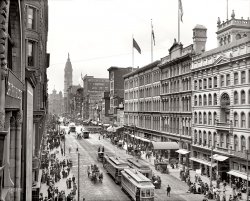
- Peacock Beverages: 1922
- ... I can get a variety called "Teddys Birch Beer" here in Oregon. It's not bad at all.
More Birch Beer Birch beer has a distinct ... Posted by Dave - 05/17/2014 - 11:45pm -
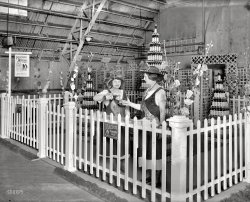
- Time and Tide: 1941
- September 1941. "By the Pacific Ocean. Seaside, Oregon." Medium format acetate negative by Russell Lee for the Farm Security ... Posted by Dave - 03/18/2022 - 9:55pm -
